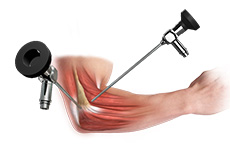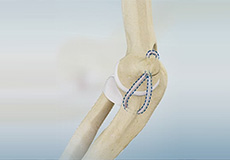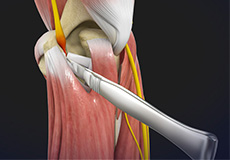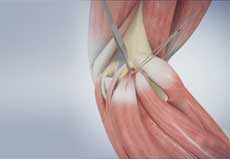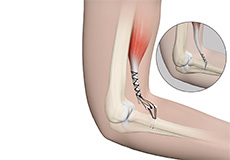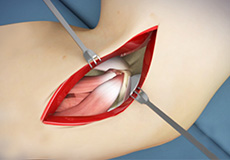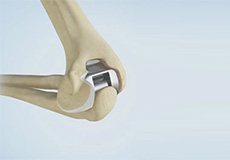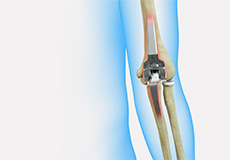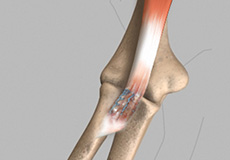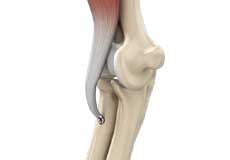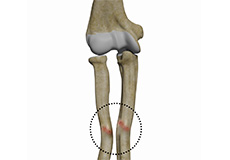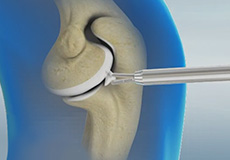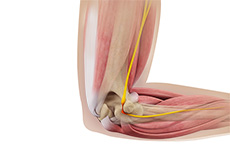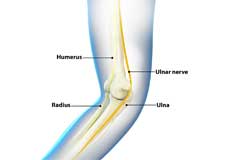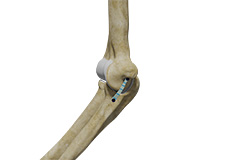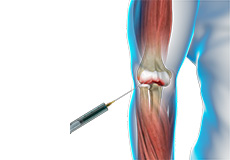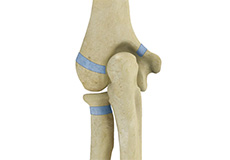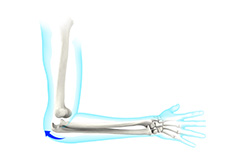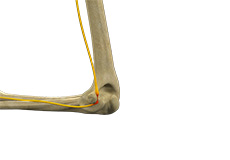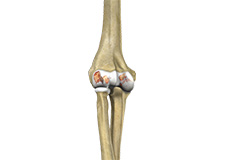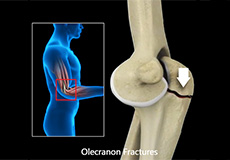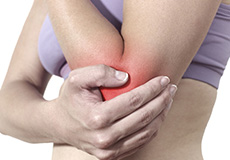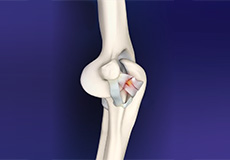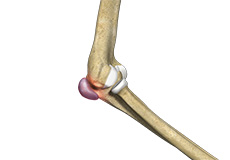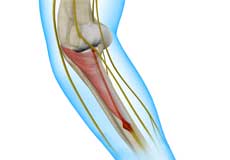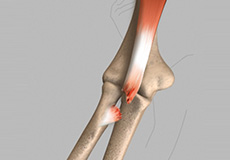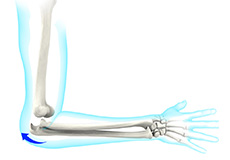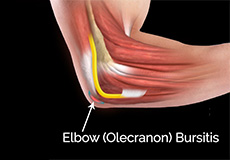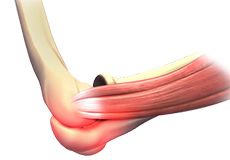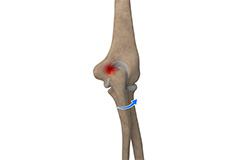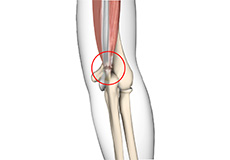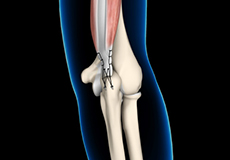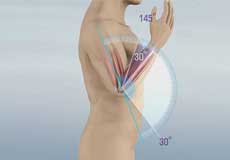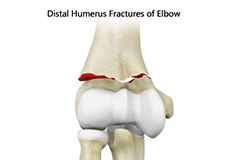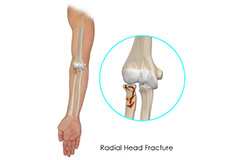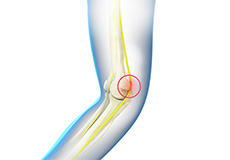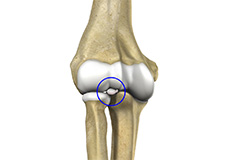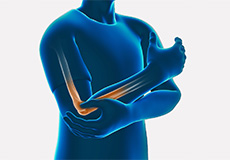-
Elbow Arthroscopy
Elbow arthroscopy, also referred to as keyhole or minimally invasive surgery, is a surgical procedure that is performed through tiny incisions to evaluate and treat several elbow conditions.
-
UCL Reconstruction (Tommy John Surgery)
Commonly called Tommy John surgery, this procedure involves reconstructing a damaged ligament on the inside of the elbow called the ulnar or medial collateral ligament with a tendon graft obtained from your own body or a donor.
-
Cubital Tunnel Surgery
Cubital tunnel release is a surgical procedure to correct cubital tunnel syndrome. Cubital tunnel syndrome is a condition characterized by compression of the ulnar nerve in an area of the elbow called the cubital tunnel.
-
Golfer's Elbow Surgery
Golfer’s elbow is a condition associated with pain on the inside of the elbow where tendons of your forearm attach to the bony prominence (medial epicondyle). It is also called medial epicondylitis and is caused by injury or irritation to the tendons which can become painful and swollen.
-
Elbow Tendon and Ligament Repair
Ligament reconstruction is considered to treat ligament rupture. Your surgeon will make an incision over the elbow. Care is taken to move muscles, tendons, and nerves out of the way. The donor's tendon is harvested from either the forearm or below the knee.
-
Open Elbow Surgery
Open elbow surgery is an operative procedure performed to treat certain conditions of your elbow through a large, open cut (incision) in the skin using a scalpel.
-
Total Elbow Replacement
Elbow joint replacement, also referred to as total elbow arthroplasty, is an operative procedure to treat the symptoms of arthritis that have not responded to non-surgical treatments. The goal of elbow joint replacement surgery is to eliminate your pain and increase the mobility of your elbow joint.
-
Revision Elbow Replacement
Revision elbow replacement is a surgery performed to replace a loose or worn out initial elbow replacement. Typically, cemented semi-constrained prostheses are used for revision elbow replacement.
-
Biceps Tendon Repair
Biceps tendon repair is a surgical procedure to restore a biceps tendon that has been torn or ruptured by severe trauma or injury. The biceps is a large muscle located in the front of your upper arm and runs from the shoulder to the elbow joint.
-
Distal Biceps Repair
The biceps is a large muscle located in the front of your upper arm and runs from the shoulder to the elbow joint. It is attached to the bones of the shoulder and elbow by tendons. The distal biceps is the area where the biceps is attached to the forearm bone in the elbow.
-
Endoscopic Cubital Tunnel Release
Endoscopic cubital tunnel release is a minimally invasive surgical procedure to decompress the ulnar nerve for the treatment of cubital tunnel syndrome. Endoscopic refers to the surgery being performed utilizing an endoscope - a thin, flexible fiber-optic tube with a camera, light, magnifying lens, and a port to pass tiny surgical instruments.
-
Malunion Surgery (Elbow)
Malunion, also known as crooked healing, is the failure of a fractured bone to rejoin properly due to poor alignment of the fracture fragments. The condition results in abnormality and deformity of the bone (bent or twisted bone).
-
Arthroscopic Debridement of the Elbow
Arthroscopic debridement of the elbow is a minimally invasive surgical procedure in which an arthroscope, a special tube-like instrument fitted with a camera and a light source, is inserted into the elbow through a tiny keyhole skin incision to identify and remove nonviable tissue and foreign debris from inside the elbow joint.
-
Ulnar Nerve Release
Ulnar nerve release, also known as ulnar nerve decompression, is a surgical procedure to treat a medical condition called ulnar nerve entrapment.
-
Ulnar Nerve Transposition
The ulnar nerve is one of the 3 main nerves in the arm that travels down from the neck through a bony protuberance inside the elbow (medial epicondyle), under the muscles of the forearm and down the hand on the side of the palm, towards the little finger.
-
Ulnar Collateral Ligament (UCL) Repair with Internal Brace
UCL repair with an internal brace is a surgery that involves the use of collagen-coated tape (internal brace) surgically placed at the site of the damaged UCL ligaments. It provides better resistant and a faster recovery compared to traditional reconstruction surgery that involves the use of graft tissue from your body.
-
Viscosupplementation for Elbow Arthritis
Viscosupplementation is a minimally invasive procedure that involves the injection of a hyaluronic acid preparation into the elbow joint to treat arthritis. Hyaluronic acid is a naturally occurring substance which is present in the joint fluid that acts as a shock absorber and enhances lubrication.
-
Golfer's Elbow
Golfer’s elbow, also called medial epicondylitis, is a painful condition occurring from repeated muscle contractions in the forearm that leads to inflammation and microtears in the tendons that attach to the medial epicondyle.
-
Little League Elbow
Little league elbow, also called medial apophysitis, is an overuse condition that occurs when there is overstress or injury to the inside portion of the elbow. It is commonly seen in children involved in sports activities that require repetitive throwing such as baseball.
-
Elbow Instability
Elbow instability is a condition in which the elbow joint occasionally slides out of alignment due to the unstable state of the joint.
-
Cubital Tunnel Syndrome (Ulnar Nerve Entrapment)
When the elbow is bent, the ulnar nerve can stretch and catch on the bony bump. When the ulnar nerve is compressed or entrapped, the nerve can tear and become inflamed, leading to cubital tunnel syndrome.
-
Throwing Injuries
An athlete uses an overhand throw to achieve greater speed and distance. Repeated throwing in sports such as baseball and basketball can place a lot of stress on the joints of the arm, and lead to weakening and ultimately, injury to the structures in the elbow.
-
Elbow Arthritis
Although the elbows are not weight-bearing joints, they are considered to be most important for the functioning of the upper limbs. Hence, even minor trauma or disease affecting the elbow may cause pain and limit the movements of the upper limbs.
-
Elbow Fractures
Elbow fractures may occur from trauma, resulting from various reasons: a fall on an outstretched arm, a direct blow to the elbow or an abnormal twist to the joint beyond its functional limit.
-
Elbow Stiffness
Elbow stiffness is a condition characterized by a restricted range of motion of the elbow causing difficulty bending, straightening, or rotating your arm. Elbow stiffness may be caused due to injury, disease, or deformity.
-
Elbow Ligament Injuries
Elbow ligament injuries are injuries to the tough elastic tissues that connect the bones of the elbow joint to each other. These ligaments stabilize the elbow while allowing an appropriate joint range of motion to occur. An acute or chronic injury to the elbow ligament can result in joint laxity and loss of elbow function.
-
Elbow Trauma
The elbow is a complex joint of the upper limb, formed by the articulation of the long bone of the upper arm or humerus, and the two bones of the forearm - the radius and ulna. It is one of the important joints of the upper limb and is involved in basic movements such as bending and extending the arm and rotating the forearm.
-
Radial Tunnel Syndrome
Radial tunnel syndrome is a painful condition caused by pressure on the radial nerve of the forearm. The entrapment or compression occurs frequently in the proximal forearm in the radial tunnel; a narrow space formed by muscles, bone, and tendon near the elbow joint.
-
Bicep Tendon Tear at the Elbow
A biceps tear can be complete or partial. Partial biceps tendon tears will not completely break the tendon while complete tendon tears will break the tendon into two parts. Tears of the distal biceps tendon are usually complete and the muscle is separated from the bone.
-
Elbow Dislocation
The arm in the human body is made up of three bones that join to form a hinge joint called the elbow. The upper arm bone or humerus connects from the shoulder to the elbow to form the top of the hinge joint. The lower arm or forearm consists of two bones, the radius, and the ulna.
-
Elbow (Olecranon) Bursitis
Inflammation of the olecranon bursa leads to a condition called olecranon bursitis. The causes of elbow bursitis may include trauma or a hard blow on the elbow, excessive leaning on the elbow, infection by puncture wounds or insect bites, or conditions such as gout and rheumatoid arthritis.
-
Elbow Sprain
An elbow sprain is an injury to the soft tissues of the elbow. It is caused due to stretching or tearing (partial or full) of the ligaments that support the elbow joint.
-
Elbow Pain
Damage to any of the structures that make up the elbow joint can cause elbow pain. An elbow dislocation occurs when the bones that make up the joint are forced out of alignment as when you fall onto an outstretched hand.
-
Elbow Impingement
Elbow impingement is a medical condition characterized by compression and injury of soft tissue structures, such as cartilage, at the back of the elbow or within the elbow joint. It is a condition caused by repetitive forced extensions and overuse of the elbow.
-
Triceps Injuries
The triceps or triceps brachii is a crucial muscle of the upper arm (humerus). It runs along the upper arm bone between the shoulder and elbow. The triceps tendons connect the triceps muscles to the shoulder blade and elbow in your arm. Tendons are strong bands of tissue that attach muscle to bone.
-
Triceps Tendonitis
Triceps tendonitis is inflammation of the triceps tendon, the tissue that connects the triceps muscle on the back of the upper arm to the back of the elbow joint, allowing you to straighten your arm back after you have bent it.
-
Elbow Contracture
Elbow contracture refers to a stiff elbow with a limited range of motion. It is a common complication following elbow surgery, fractures, dislocations, and burns.
-
Distal Humerus Fractures of the Elbow
Injury in the distal humerus can cause impairment in the function of the elbow joint. A distal humerus fracture is a rare condition that occurs when there is a break in the lower end of the humerus.
-
Radial Head Fractures of the Elbow
Radial head fractures are very common and occur in almost 20% of acute elbow injuries. Elbow dislocations are generally associated with radial head fractures. Radial head fractures are more common in women than in men and occur more frequently in the age group of 30 to 40 years.
-
Ulnar Nerve Neuropathy
Ulnar nerve neuropathy is the entrapment or compression of the ulnar nerve causing impairment of its function. The branches from the spinal nerve C8 (cervical) and T1 (upper thoracic) give rise to the ulnar nerve that passes close to the ulna bone of the forearm.
-
Loose Bodies in the Elbow
Your elbow is a joint made up of three bones held together by muscles, ligaments, tendons, and cartilage. It is both a hinge and pivot joint allowing you to bend and rotate your elbow freely. Loose bodies in your elbow are small pieces of bone or cartilage that have broken off and are lying or floating free within the joint.
-
Post-traumatic Stiffness (Elbow)
Medically, stiffness is difficulty moving a joint due to the loss of the joint’s range of motion caused by an injury (trauma) or a disorder. Post-traumatic stiffness is a disabling complication caused by trauma resulting in reduced or loss of motion and functional impairment.
The elbow is a complex joint formed by the articulation of three bones – the humerus, radius, and ulna. The elbow joint helps in bending or straightening of the arm to 180 degrees and lifting or moving objects.
The bones of the elbow are supported by:
- Ligaments and tendons
- Muscles
- Nerves
- Blood vessels
Bones and Joints of the Elbow
The elbow joint is formed at the junction of three bones:
- The humerus (upper arm bone) forms the upper portion of the joint. The lower end of the humerus divides into two bony protrusions known as the medial and lateral epicondyles, which can be felt on either side of the elbow joint.
- The ulna is the larger bone of the forearm located on the inner surface of the joint. It articulates with the humerus.
- The radius is the smaller bone of the forearm situated on the outer surface of the joint. The head of the radius is circular and hollow, which allows movement with the humerus. The articulation between the ulna and radius helps the forearm to rotate.
The elbow consists of three joints, namely:
- The humeroulnar joint is formed between the humerus and ulna and allows flexion and extension of the arm.
- The humeroradial joint is formed between the radius and humerus and allows movements like flexion, extension, supination, and pronation.
- The radioulnar joint is formed between the ulna and radius bones and allows rotation of the lower arm.
Articular cartilage lines the articulating regions of the humerus, radius, and ulna. It is a thin, tough, flexible and slippery surface that acts as a shock absorber and cushion to reduce friction between the bones. The cartilage is lubricated with synovial fluid, which further enables the smooth movement of the bones.
Muscles of the Elbow Joint
There are several muscles extending across the elbow joint that help in various movements. These include the following:
- Biceps brachii: Upper arm muscle, enabling flexion of the arm
- Triceps brachii: Muscle in the back of the upper arm that extends the arm and fixes the elbow during fine movements
- Brachialis: Upper arm muscle beneath the biceps, which flexes the elbow towards the body
- Brachioradialis: Forearm muscle that flexes, straightens and pulls the arm at the elbow
- Pronator teres: Muscle that extends from the humeral head, across the elbow, and towards the ulna, and helps to turn the palm facing backward
- Extensor carpi radialis brevis: Forearm muscle that helps in movement of the hand
- Extensor digitorum: Forearm muscle that helps in movement of the fingers
Ligaments and Tendons of the Elbow
The elbow joint is supported by ligaments and tendons, which provide stability to the joint.
Ligaments are a group of firm tissues that connect bones to other bones. The most important ligaments of the elbow joint are the:
- Medial or ulnar collateral ligament: Comprised of triangular bands of tissue on the inner side of the elbow joint
- Lateral or radial collateral ligament: A thin band of tissue on the outer side of the elbow joint
- Annular ligament: Group of fibers that surround the radial head, and hold the ulna and radius tightly in place during movement of the arm
Together, the medial and lateral ligaments are the main source of stability and hold the humerus and ulna tightly in place during movement of the arm.
The ligaments around a joint combine to form a joint capsule that contains synovial fluid.
Any injury to these ligaments can lead to instability of the elbow joint.
Tendons are bands of connective tissue fibers that connect muscle to bone. The various tendons that surround the elbow joint include:
- Biceps tendon: attaches the biceps muscle to the radius, allowing the elbow to bend
- Triceps tendon: attaches the triceps muscle to the ulna, allowing the elbow to straighten
Nerves of the Elbow
The main nerves of the elbow joint are the ulnar, radial and median nerves. These nerves transfer signals from the brain to the muscles that aid in elbow movements. They also carry sensory signals such as touch, pain, and temperature back to the brain.
Any injury or damage to these nerves causes pain, weakness or joint instability.
Blood Vessels Supplying the Elbow
Arteries are blood vessels that carry oxygen-pure blood from the heart to the hand. The main artery of the elbow is the brachial artery that travels across the inside of the elbow and divides into two small branches below the elbow to form the ulnar and the radial artery.


